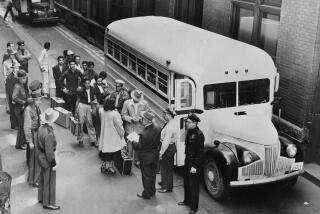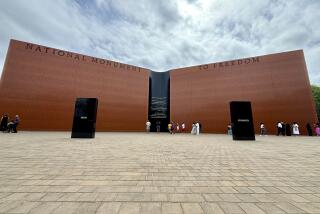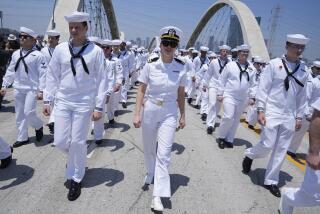New monument honors Filipino American vets
- Share via
Six decades after their service during World War II, Filipino American veterans were honored in Los Angeles on Veterans Day with the dedication of a granite monument that tells their story.
Several hundred people, including aging veterans in uniform with medals pinned to their chests, attended Saturday’s unveiling ceremony at Lake Street Park and Recreation Center, west of downtown.
Afterward, they took part in a Veterans Day parade through the city’s historic Filipinotown, their motorcade festooned with flags, placards and balloons.
“It’s a good day for Filipino American veterans,” said Mike Pedro, a Filipino American and Cal Poly Pomona senior who had come with 20 classmates.
Believed to be the first such monument in the United States, the striking artwork stands inside the gated park in the 200 block of North Lake Street -- a tree-lined neighborhood of modest homes with iron bars on windows.
Designed by Silver Lake artist Cheri Gaulke, the monument consists of five tall, black granite slabs. Each one tells a piece of Filipino American history, beginning with U.S. colonial occupation of the Philippines. The narrative ends with the veterans’ long fight for honor and status as American veterans.
“It’s beautiful,” said Pedro as he viewed it. “It’s empowering, awe-inspiring.”
The back of the monument reads VALOR -- one letter to a slab. It also carries a quote from octogenarian Faustino “Peping” Baclig, a survivor of the Bataan death march and longtime leader of the movement to gain financial and medical benefits for the veterans. “Bataan was not our last battlefield. We are still fighting for equity.”
President Franklin D. Roosevelt commissioned 120,000 Filipino citizens, then living in their homeland, into the U.S. armed services under Gen. Douglas MacArthur. The Philippines at the time was a U.S. commonwealth.
After the war, despite the fact that Filipinos had fought in some of the toughest battles alongside their American counterparts, Congress reneged on Roosevelt’s wartime promises of U.S. citizenship and full veterans benefits for them.
Over the years, Baclig and fellow veterans have chained themselves to the statue of MacArthur in L.A.’s MacArthur Park, have gone on hunger strikes and have been arrested during a demonstration in front of the White House to get benefits comparable to those of their American counterparts.
Congress granted the veterans citizenship rights in 1990, prompting more than 20,000 elderly Filipino men to leave their country for the United States, half of them settling in the Los Angeles region.
In 2001, it was estimated that it would cost about $145 million a year to give pension and other benefits to all the Filipino veterans, with $15 million of that going to veterans now living in the U.S.
Officiating at Saturday’s event, City Council President Eric Garcetti, whose grandfather fought in the Philippines alongside Filipino soldiers, called the memorial a token of Los Angeles’ appreciation for their contribution to the cause of freedom.
“Today is an historic day in historic Filipinotown,” he said, “an historic day for the United States of America and for the Philippines.”
The monument was made possible by a $75,000 federal community development block grant, he said. A local Filipino community group will maintain it.
Some of the veterans at the ceremony were so frail, they had to be helped to the podium.
Michael Berino, a senior at Loyola Marymount University, said the memorial will help bring together Filipinos of different ages.
“Coming to America, there’s been a huge divide between the younger generation and the older generation, who are the Filipino American veterans,” he said. “Going to this event brings a lot of awareness.”
Rep. Xavier Becerra (D-Los Angeles) promised the gathering that he would work to help the veterans gain their benefits.
“With a new day in Washington, D.C., I will do everything I can,” he said.
Apifannia Beltran, a World War II veteran, dabbed her tear-filled eyes with a handkerchief as she left the memorial site, helped by a friend.
“I am so touched,” she said. “It has taken a long time.”
More to Read
Sign up for Essential California
The most important California stories and recommendations in your inbox every morning.
You may occasionally receive promotional content from the Los Angeles Times.










